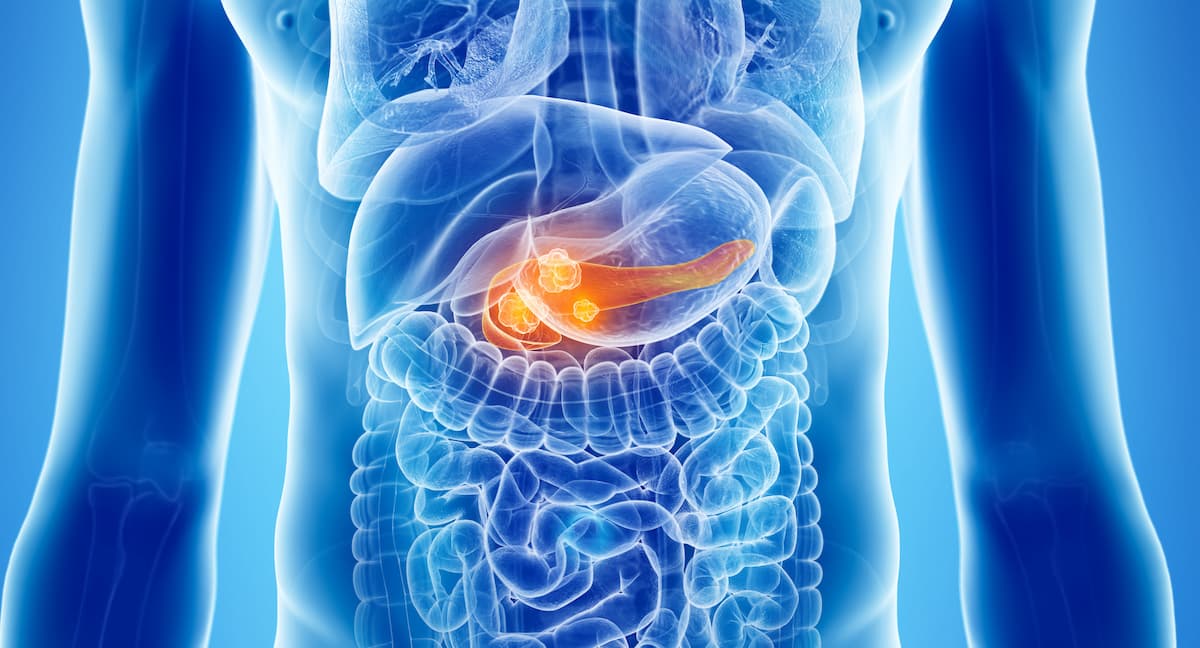Nadunolimab Combo Shows Promising Efficacy in Advanced/Metastatic PDAC
Results from the CANFOUR trial of combining nadunolimab with chemotherapy appear to prolong overall survival among those with advanced or metastatic PDAC.
“…Nadunolimab combined with GN showed manageable toxicity and promising overall efficacy in first-line treatment for locally advanced/metastatic PDAC. The increased toxicity seems to be restricted to IRRs and neutropenia,” according to study author Eric Van Cutsem, MD, PhD.

Nadunolimab (CAN04), an investigational IL-1 receptor accessory protein (IL1RAP)–targeting antibody, plus gemcitabine/nab-paclitaxel (GN) demonstrated promising efficacy and a manageable safety profile among patients with locally advanced or metastatic pancreatic ductal adenocarcinoma (PDAC), according to findings from the phase 1/2a CANFOUR trial (NCT03267316) published in Clinical Cancer Research.1
Across all dose levels, study treatment yielded a median overall survival (OS) of 13.2 months (95% CI, 10.6-15.5) and a survival probability of 58% at 1 year. A partial response (PR) as the best response was reported in 32% (95% CI, 21%-43%) of patients per RECIST v1.1 criteria, and the disease control rate (DCR) was 71%. Additionally, data showed a median progression-free survival (PFS) of 5.6 months (95% CI, 3.7-7.4) and a median duration of response (DOR) of 6.5 months (95% CI, 5.5-10.0).
Among patients with high IL1RAP expression, treatment with nadunolimab/GN produced a median OS of 14.2 months vs 10.6 months in those with low IL1RAP expression, with 1-year survival rates of 67% vs 39% in each respective group (P = .012). In each respective IL1RAP expression group, the median PFS was 7.4 months vs 5.1 months, the objective response rate (ORR) was 48% vs 30%, and the median DOR was 8.7 months vs 5.6 months.
The most common any-grade treatment-emergent adverse effect (TEAE) was neutropenia (76%). Additionally, common grade 3/4 TEAEs included neutropenia (66%), leukopenia (24%), elevated gamma-glutamyltransferase (17%), anemia (14%), febrile neutropenia (13%), and thrombocytopenia (13%).Infusion-related reactions (IRRs) affected 29% of patients, with 3% experiencing grade 3 events. Investigators observed no grade 3/4 peripheral neuropathy, although 1 patient had grade 3 polyneuropathy.
“…Nadunolimab combined with GN showed manageable toxicity and promising overall efficacy in first-line treatment for locally advanced/metastatic PDAC. The increased toxicity seems to be restricted to IRRs and neutropenia,” Eric Van Cutsem, MD, PhD, a full professor and division head of Digestive Oncology at the University of Leuven and University Hospitals Gasthuisberg, Leuven, Belgium, and coauthors wrote.1 “Compared [with] historical data, the addition of nadunolimab to GN produced clinically relevant improvements in PFS and OS. This was particularly marked in patients whose tumors had high baseline expression of IL1RAP, supporting the mode-of-action of nadunolimab.”
In the CANFOUR trial, patients with previously untreated locally advanced or metastatic PDAC were assigned to receive nadunolimab at doses ranging from 1.0 mg/kg to 7.5 mg/kg every 2 weeks in combination with standard GN. Chemotherapy consisted of gemcitabine at 1000 mg/m2 plus nab-paclitaxel at 125 mg/m2 on days 1, 8, and 15 of every 28-day cycle.
The trial’s primary end point was safety. Secondary end points included anti-tumor response, PFS, and OS. Investigators also assessed how serum and tumor biomarkers potentially correlated with clinical responses.
Patients 18 years and older with newly diagnosed, histologically or cytologically confirmed, unresectable, locally advanced or metastatic PDAC and an ECOG performance status of 0 or 1 were eligible for enrollment on the trial. Those who received prior neoadjuvant or adjuvant therapy were eligible to enroll if these treatments were terminated at 6 months or longer prior to study entry.
Overall, the study included 76 patients, and the median age was 63 years (range, 43-89). Across the entire study population, most patients were male (58%), had stage IV disease at initial diagnosis (80%), and had a tumor localized in the liver (65%).
“The efficacy and safety results, particularly the striking efficacy of the IL1RAP high subgroup as well as the lower-than-expected incidence of severe neuropathy, highlight the potential of nadunolimab as a cancer therapy which may provide antitumor effects together with a protective effect when combined with chemotherapy,” Dominique Tersago, chief medical officer at Cantargia, the developer of nadunolimab, said in a press release on these findings.2
References
- Cutsem EV, Collignon J, Eefsen RL, et al. Efficacy and safety of the anti-IL1RAP antibody nadunolimab (CAN04) in combination with gemcitabine and nab-paclitaxel in patients with advanced/metastatic pancreatic cancer. Clin Cancer Res. Published online October 10, 2024. doi:10.1158/1078-0432.CCR-24-0645
- Cantargia’s strong phase 2 clinical data in pancreatic cancer with nadunolimab published in Clinical Cancer Research. News release. Cantargia. October 10, 2024. Accessed October 11, 2024. https://tinyurl.com/3un89cf9
Pelareorep Combination Shows Manageable Safety in Metastatic Pancreatic Cancer
January 25th 2025Cohort 5 of the ongoing phase 1/2 GOBLET study evaluated the safety of pelareorep in combination with modified FOLFIRINOX with or without atezolizumab in patients with newly diagnosed metastatic pancreatic ductal adenocarcinoma.